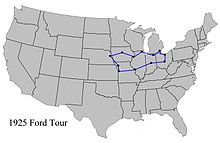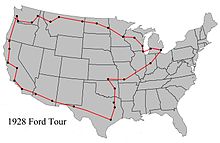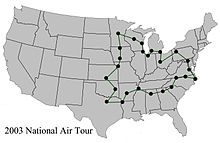- Ford National Reliability Air Tour
-
The Ford Reliability Tour, properly called "The National Air Tour for the Edsel B. Ford Reliability Trophy", was a series of Aerial Tours sponsored in part by Ford from 1925 to 1931 and re-created in 2003. Top prize was the Edsel Ford Reliability Trophy.[1] Henry and Edsel Ford were shareholders in the Stout Engineering Company. In August of 1925, they purchased the entire company, making it the Stout Metal Airplane Division of the Ford Motor Company. Their product, the Stout 2-AT Pullman, was a featured plane. The plane was also used by their new airline the Ford Air Transport Service, which started regular flights in April. The Flights out of Ford Airport (Dearborn) cross-marketed, and showcased Ford's new interest in aviation.[2]
Contents
1925 National Air Tour
This was called the First Annual Aerial Reliability Tour, sponsored by the Society of Automotive Engineers, with prizes for completion. The course was over 1900 miles with stops in 10 cities.
September 28, 1925 to October 4, 1925: 20 Entered, 17 Starters, 11 with a perfect score.
Perfect Scores - (unless noted)
- E.K. Campbell - Travel Air A
- C. Bowhan - Travel Air B.6
- Walter Beech - Travel Air B.6
- Fred Melchoir - Junkers F.13L (second prize)
- E. G. Knapp - Waco (fourth prize - damaged in forced landing)
- L. O. Yost - Waco
- J. Stauffer - Swallow '25 (second prize)
- Earl Rauland - Swallow '26
- P. Lott - Fokker 3F7
- Casey Jones - Curtiss Carrier Pigeon
- Gy Caldwell - Martin Commercial
- L.B. Richardson - Martin Commercial
- H.C. Mummert - Mercury Jr. (third prize)
- E.G. Hamilton - Stout 2-AT Pullman.
- H.C. Etten - Laird Special (second prize)
- E.A. Goff - Laird Swallow (second prize)
- W.J. Adams - Yackey[3]
1926 National Air Tour
The 1926 Air tour started at Ford Field on August 7, 1926. The event featured the unvieling of the prototype Ford Flivver.[4] There was a field of 25 contestants. A new scoring system for time to "stick" and "unstick" aircraft to the ground helped promote the use of brakes which were unpopular at the time.
The new Ford Trimotor had a prop failure that shook loose one landing gear and a engine on one side. The plane landed hard in a field at Nova, Ohio. Walter Beech won in a Travel Air aircraft.[5]
- A Pitcairn PA-2 Sesquiwing won in two of the classes.[6]
- Clarence E Clark placed seventh in a Travel Air 3000[7]
- Vance Breese placed eighth in a Ryan M-1.
1927 National Air Tour
In 1927, fourteen contestants competed in the air tour.[8] The winner was Eddie Stinson in a Stinson SM-1. The Hamilton H-18 Metalplane “Maiden Milwaukee" placed second.
1928 National Air Tour
1928 featured destinations as far west as Washington state. The launch was timed the same day at Ford Airfield with the 22nd Annual James Gordon Bennett Balloon Race. Phoebe Omlie became the first female air tour pilot flying a Monocoupe. The route placed racers in San Francisco at the same field where Hells Angels was filming.[9]
- The winner was John P. Wood in a Waco 10
1929 National Air Tour
The 1929 winner was John Livingston [10]
1930 National Air Tour
September 11, 1930 to September 27, 1930:
- 1 Harry L. Russell
- 2 John H. Livingston
- 3 Arthur J. Davis
- 4 Myron E. Zeller
- 5 George W. Haldeman
- 6 Walter H. Beech
- 7 J. Wesley Smith
- 8 Eddie August Schneider in his Cessna and he wins the Great Lakes Trophy[11]
Among the aircraft, a Pitcairn PCA-2 autogiro was flown by pilot Jim Ray, bringing rotory winged aircraft to the event.William F. Trimble. High frontier: a history of aeronautics in Pennsylvania.</ref>
1931 National Air Tour
July 4, 1930 to July 25, 1930:
- 3 Eddie August Schneider, first in single engine aircraft[12]
- 4 Lowell Bayles; Great Lakes Trophy
Time (magazine) wrote:
Sensation of the meet was the youngster Eddie Schneider, 19, who fell into last place by a forced landing of his Cessna and a three-day delay in Kentucky, then fought his way back to finish third, ahead of all other light planes.[13]
The following comes from a New York paper:
The second day of the 1931 National Air Tour for the "Edsel B. Ford Trophy" today, was to find the 14 competing planes and a dozen accompanying planes en route from Le Roy, New York, to Binghamton, New York. From Binghamton, the tour is to fly south and west as far as San Antonio, Texas, returning to Ford Airport July 25, 1931. A holiday crowd of about 5,000 persons witnessed the start of the tour from the Ford Airport Saturday morning. Colonel Clarence M. Young, assistant Secretary of Commerce for Aeronautics, came from Cleveland, Ohio to witness the start. Fifteen Army planes from Selfridge Field stunted over the field just before the takeoff and accompanied the tour planes as far as Walker Airport, Walkerville, Ontario At Walker Airport, where the tour planes stopped for a long luncheon hour, they joined the large number of planes participating in the Trans-Canada Air Pageant there. Most of the racers got off to a bad start from Ford Airport. Only flying a Mercury Chic, Captain William Lancaster, flying a Bird and Eddie Schneider, flying a Cessna, got away on time. Leonard Flo, flying a Bird cabin plane, was delayed more than a half hour when he broke a tail skid just before the takeoff and the two Ford entries were 15 minutes late. The racers were timed from the minute they were supposed to take off. Other entries are Charles F. Sugg, Captain Walter Henderson and Jack Story, flying Buhl entries; James H. Smart and Harry Russell, flying Ford trimotors; Joseph Meehan, flying a Great Lakes; Lowell Bayles, flying a Gee Bee; Eddie Stinson, flying a Stinson and George Dickson, flying an Aeronca. Among the well-known pilots flying accompanying planes are Major James H. Doolittle, referee of the tour, who is accompanied by Mrs. Doolittle and Mrs. Ray W. Brown, wife of the assistant tour starter; Capt. Lewis A. Yancey, who flew with Roger Q. Williams across the Atlantic in 1928, who is piloting an autogiro in the tour; Walter E. Lees, Detroit pilot who holds the world's non-refueling endurance record, and George Haldeman, who attempted to fly the Atlantic with Ruth Elder. Major Thomas G. Lanphier, former commandant at Selfridge Field, is accompanying the tour as far as Binghamton as a passenger. Night stops after tonight will be as follows: Monday, Bradford, Pennsylvania; Tuesday, Wheeling, West Virginia; Wednesday, Huntington, West Virginia; Thursday, Knoxville, Tennessee; Friday, Memphis, Tennessee; Saturday, Birmingham, Alabama; July 12, Montgomery, Alabama; July 13, New Orleans; July 14, Shreveport, Louisiana; July 15, Houston, Texas; July 16, San Antonio, Texas; July 17 and 18, Fort Worth, Texas; July 19, Ponca City, Oklahoma; July 20, Kansas City; July 21, Lincoln, Nebraska; July 22, Omaha, Nebraska; July 23, Davenport, Ia.; July 24, Kalamazoo, Michigan; July 25, Detroit, Michigan. The tour will cover more than 6,000 miles, visiting 18 states. The Ford Trophy will go to the pilot whose plane performs most efficiently, as judged by the scoring formula, over the entire distance. A separate trophy, the Great Lakes Light Plane Trophy, will go to the pilot of the plane of less than 510 cubic inches engine displacement which makes the best score.
2003 Re-creation
The tour was re-created in 2003 from the plans for the canceled 1932 tour. More than 30 vintage aircraft took part. Most participating aircraft were from the same period of the original National Air Tours. The tour covered 4,000 miles and 27 cities. The public was able to see a great many historic planes land and take off as well as ask questions and tour the inside of several of the larger planes. The 2003 National Air Tour Web site is: www.NationalAirTour.org
References
- ^ "National Air Tour". National Air Tour. http://www.nationalairtour.org/read_book.html. Retrieved 2007-09-25.
- ^ David L. Lewis. The Public Image of Henry Ford An American Folk Hero and His Company.
- ^ Flight - The Aircraft Engineer and Airships, "The Ford Reliability Tour" November 26, 1925
- ^ Robert F. Pauley (July 1961). "The Ford Flivver". Sport Aviation.
- ^ Forden, Lesley. The Ford Air Ttours: 1925-1931. New Brighton Minnesota: Aviation Foundation of America, 2003, First edition 1972. No ISBN.
- ^ "Pitcairn". http://www.nationalaviation.org/pitcairn-harold/. Retrieved 21 Jan 2011.
- ^ "Clarence E. Clark". http://www.dmairfield.org/people/clark_ce/index.html. Retrieved 23 August 2011.
- ^ Forden, Lesley. The Ford Air Ttours: 1925-1931. New Brighton Minnesota: Aviation Foundation of America, 2003, First edition 1972. No ISBN.
- ^ Forden, Lesley. The Ford Air Ttours: 1925-1931. New Brighton Minnesota: Aviation Foundation of America, 2003, First edition 1972. No ISBN.
- ^ Sport Aviation. July 1958.
- ^ Kieran, Leo A. (October 5, 1930, Sunday). "Fast Flying Marked Ford Tour. Full-Throttle Speeds for Most of 4,900-Mile Route in Canada and Northwest Gave New Practical Meaning to Reliability Test.". New York Times. http://select.nytimes.com/gst/abstract.html?res=F40917F9355E1B728DDDAC0894D8415B808FF1D3. Retrieved 2007-09-25. "Under the new formula, which made speed the most important characteristic of the modern airplane, the National Air Tour ended its 4,900-mile trip at Detroit last week as the most exacting and exhaustive demonstration ever conducted on a fleet of representative commercial and training airplanes. ... The flying of the pilots was declared perfect, and the technique and navigation of Miss Nancy Hopkins, only woman pilot, Edward Schneider and Truman Wadlow, three of the youngest pilots in the troupe, was equal to that of the older and more experienced racing pilots. In winning the Great Lakes Trophy for light planes in the tour Schneider beat out pilots who had a much better wingpower load ratio by sheer speed and good navigation. ... Cessna; Schneider; 8th overall finish; Warner engine; 110 HP; 1,225 pounds; 1,035 useful load; 47,488.0 points; 113.1 mph average."
- ^ "Ford National Reliability Air Tour". Western Aerospace. 1962. "Third place was captured by Eddie Schneider flying a Warner Scarab-powered Cessna monoplane, while Lowell R. Bayles took fourth place flying a Warner ..."
- ^ "Ford's Reliability". Time (magazine). August 3, 1931. http://www.time.com/time/magazine/article/0,9171,846954,00.html. Retrieved 2007-08-21. "Sensation of the meet was the youngster Eddie Schneider, 19, who fell into last place by a forced landing of his Cessna and a three-day delay in Kentucky, then fought his way back to finish third, ahead of all other light planes."
External links
Categories:
Wikimedia Foundation. 2010.



